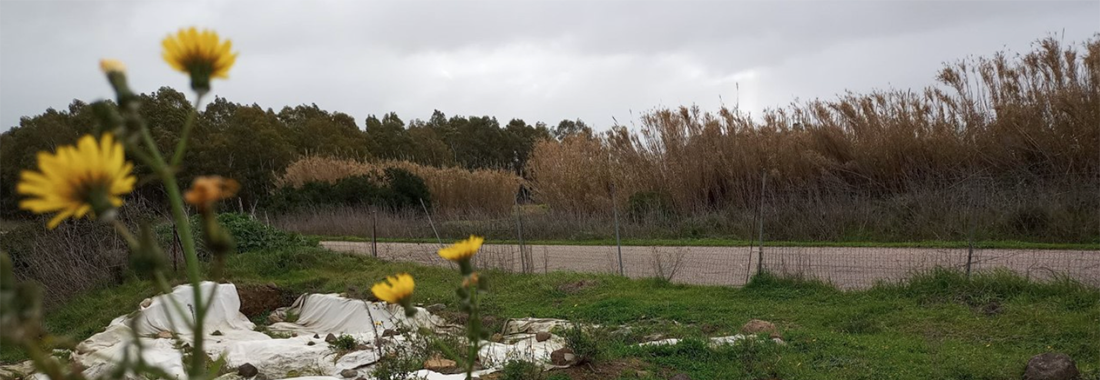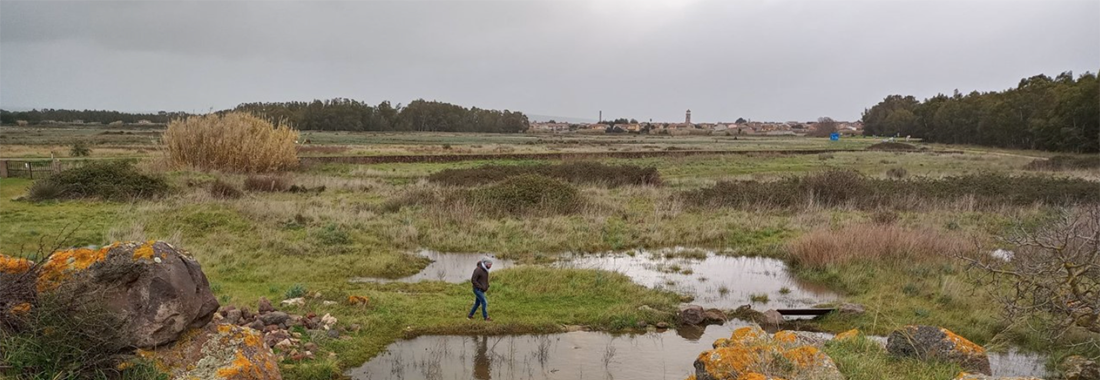S’Urachi is a journey through time and into the unfolding mystery, an exercise for the the mind and its focus to the wonder of history, the role it has in the present, in the possible paths of the future. The low and gray sky envelops the countryside of San Vero Milis, giving it an atmosphere of a moorland. The nuraghe is a lump of earth and stones covered with dry moss, which rises inconspicuously next to the provincial road. Around the bare trees, a small swamp created by the persistent rains of recent weeks, the white sheets propped up by the stones that preserve the last stage reached by the excavations.
"When the young prof. Lilliu and the superintendency decided to start the works, in 1948, this was just a hill. It was only visited to collect the clay that was used for the construction of the town", says Alfonso Stiglitz, director of the civic museum of San Vero Milis and archaeologist who for forty years has been investigating Sardinia’s I millennium in the Gulf of Cagliari and Oristano, and their relations with the eastern Mediterranean. The first excavations brought to light the wall, the towers that announce and protect the actual nuraghe, which is entirely covered with earth. The research was soon interrupted, only to resume in the 1980s, with some excavation campaigns directed by prof. Giovanni Tore of the University of Cagliari. Then again in 1995 and 2005, when Stiglitz himself and Dr. Alessandro Usai of the Archaeological Superintendence. Finally, in 2013, the venture of Stiglitz and prof. Peter Van Dommelen of Brown University, one of the oldest and most prestigious American universities, began. For seven years, every summer they have been digging for five weeks. 25 scholars converge on San Vero Milis from all over the world. The goal is to reconstruct the environmental, social and cultural microcosm of Nurachi, a fundamental center in the long Nuragic season of the Oristano area. “Men are the center of archaeology. Walls and shards serve only to tell their story”, says Stiglitz.
In order for the enterprise to be completed, S’Urachi hosts various forms of collaboration. At Harvard University, interested in the study of oxygen isotopes, Stiglitz and Van Dommelen provide archaeological materials that emerge from the excavations, especially human and animal bones. An extraordinary collection, which includes the oldest chicken bone in Europe, dating back to the 7th century BC. “A chicken with a certain dignity”, jokes Stiglitz. The common domestic rooster has exotic origins, it comes from India and Cambodia, and arrived in our country thanks to the Phoenicians. Uncovering the actual nuraghe is extremely demanding and expensive. The ice ax is not enough, other means are needed to unveil and shore up the ancient structure. The perimeter area, in addition to being less expensive, preserves life: collections of seeds, an oak trunk from the eighth century BC, ceramics.
The Nuragic life sleeps under the geotextiles, which preserves the work and slows down the growth of vegetation, so that at the end of June the week of thinning the grass around can be avoided. The days of excavation begin at 7 in the morning. Some go to the site, others remain at the museum, bent over the study of the material. The excavation goes on until lunch. In the afternoon finds are cleaned, the shards washed, translated into a drawing. The site’s documentation is compiled. The group, in addition to be ready to sacrifice a member to explain the story of S’Urachi to anyone who comes along, organizes an open day for the curious, its over five weeks stay. A final conference collects and exhibits the summer discoveries.
S’Urachi was also frequented in pre-Nuragic times. This is demonstrated by the discovery of several out of context ceramic fragments. A fairly common fact for the Sinis peninsula, where the Domus de Janas attest human presence since the fourth millennium. Stiglitz hypothesizes that the central nuraghe was built between the fifteenth and fourteenth centuries, and the ten very regular towers that make up the bulwark (and make S'Urachi similar to the famous complex of Barumini) belong instead to the Recent Bronze. The turning point takes place in the eighth century, when the first Phoenician finds appear and most of the Nuragic sites in the area abandoned, but not S'Urachi. The Nuragic and Phoenician ceramics, initially distinguished by technique, shape and decoration, begin to merge. The faired cups become indistinguishable. “The Nuragic artisans experiment, they no longer suffer the problem of identity. At the end of the seventh and early sixth centuries, the Nuragic objects disappeared. Only the new materials and new forms remain. It is the hybridization, a community was born that we do not define neither Nuragic nor Phoenician. I call them Sardinians, with a capital S”, says Stiglitz.
The depopulation that the Sinis Peninsula and the territories that embrace the Gulf of Oristano undergo are part of a wider phenomenon, which all affects the Mediterranean basin. Between the second half of the eighth century and the end of the seventh, the people of the Mare Nostrum are urbanizing, the tendentially egalitarian societies slide towards stratification. “Some speak of clans, others of lineages. I, softly, speak of classes", explains the anthropologist. The city where S’Urachi's population gradually converges is Tharros. This is demonstrated by the presence of the Tophet, the typical Phoenician sanctuary. Not all the Nuragic centers are crossed by the process that leads to hybridization. No artifacts belonging to the 1000-year-old Phoenician urban culture have been found in renowned Mont'e Prama site.
Hence the extraordinary importance of S’Urachi, which Stiglitz imagines as a Nuragic crossroads between two shores of landing on the sea, Mistras and Su Pallosu, the Montiferru where iron and timber were obtained, and the cultivated plain. A strategic center for production and logistics, capable of welcoming Levantine influences and then following them in the transition of the urban era. A fascinating paradigm, a mosaic to be completed through research, which proceeds parallel in the Nuragic village of Tharros (discovered in the 1970s), under the direction of Alessandro Usai. Between the sea, the mountains, the plains and the wetlands: S’Urachi lay a short distance from Mar’e Foghe, a large pond now channeled into a river. And then, at close distance, the pond of Cabras, and Sal’e Porcus. Built on a very powerful water vein that suggested the construction of a moat with embankments in front of the bulwarks. Even today a few excavations are enough to bring out the aquifer. The Nuragic people of S’Urachi did not fear water, nor the sea, nor its peoples.

The Island made of mussels in Corru Mannu's pond began to be populated by birds
Little tern, common tern, sandwich tern, rosy gull and black-winged stilt are some of the bird species that have found a home in Corru Mannu in recent weeks. Thanks to…

Sardinian Wetlands, the best way to protect them is "to manage them"
Cagliari, 04.02.2023 – Le zone umide sono ecosistemi acquatici sempre più rilevanti, conoscerli meglio è il primo passo per tutelarli, ma non è tutto. “Serve uno strumento di gestione” per…

The II D from Terralba Institute visited the Old Tower of Marceddì as prize for Terre d'Acqua school contest 2022
Learning about the role of these precious and very important ecosystems, as well as the specificities of the large wetland area of Oristano. In recent days we have accompanied the…

Maristanis was showcased at the Ramsar COP 14 on wetlands during a side event
The 14th meeting of the Ramsar Wetlands Conference (COP14) was held in Geneva from 5 to 13 November 2022, simultaneously also in Wuhan, China. At the International Conference Center in Geneva (CICG) all…

Learning from the Maristanis's model in the ENSERES's visit exchange
Two days to study an integrated management model of marine-coastal systems, two days to strengthen ties and develop new strategies for a sustainable future of the Mediterranean. The Italian stage…

A step forward for the Maristanis project, towards the Regional Park of wetlands in Sardinia
The Municipal Council of Oristano, on the proposal of the Councilor for the Environment Maria Bonaria Zedda, has launched the participatory process and the preparatory actions necessary for the establishment…

Evaluating ecosystem services by the TESSA Methodology in Arborea
How to understand the effects on natural capitals and actual and potential state changes of individual sites important in promoting decisions to support both biodiversity conservation and ecosystem service provision?

Terre D'Acqua 2022, the winners of the school contest within the Maristanis Project
With 87 works, of which 84 in the drawing category and 3 in the comics category, the MEDSEA Foundation's Terre D’Acqua 2022 Competition ends. The school contest took place from February…

The Sardinian farms met in Arborea under the sign of Sustainability
This is the year of relaunch for the La Fiera dell’agricoltura di Arborea (Agricultural Fair of Arborea), one of the most important thematic fairs in Sardinia that promotes the productive, agro and…

Maristanis in the news: Rai and Italia 1 dedicated ample space to the Maristanis Project
The Italian press gave ample space to the Maristanis project in recent months, the Oristanese wetlands and its most important project Maristanis were told in various national and local television reports on…

The winner of the World Wetlands Day in Sardinia 2022 Contest
With a picture taken in the Oristanese lagoons representing a group of flamingos and the sentence "They come / They come back / Sometimes they stop / Like nomads /…

Over 700 visitors for the World Wetlands Day Calendar
Over 700 visitors in the World Wetlands Day collective calendar, put together by the MEDSEA Foundation, as part of the Maristanis project last February, with the aim of promoting the precious…

The World Wetlands Day 2022 in Sardinia lasts a month, the events Calendar
As every year, the World Wetlands Day on the anniversary of the RAMSAR convention (of 1971, Feb. 2nd) calls and Sardinia, in particular the Oristanese area, replies within the Maristanis project that…

World Wetlands Day in Sardinia, from 2 to 27 February join the competition #WWDSardegna on Instagram
In the occasion of the World Wetlands Day which celebrates ponds and lagoons in the world next February 2, the MEDSEA foundation launches the contest on wetlands in Sardinia with the hashtag #WWDSardegna to…

MAVA Steering Committee in Provence: Sardinia was promoted with the Maristanis project
MEDSEA foundation, which has been carrying out the Maristanis project in the Oristano area in Sardinia since 2017, attended last week the yearly meeting of the MAVA steering committee. The session took place from 16 to 17 December 2021 in Châteauneuf-le-Rouge, in the Provence-Alpes-Côte d'Azur region, and gathered together the…

Terre d'Acqua, a wetlands school competition for students in the Oristanese
On February 2, the World Wetlands Day will be celebrated once again the Oristanese wetlands region. To recall the central role of wetlands in addressing climate and environmental crisis and to raise awareness of the importance of these basins especially in this west coast side…
- 1
- 2
- 3
- 4


